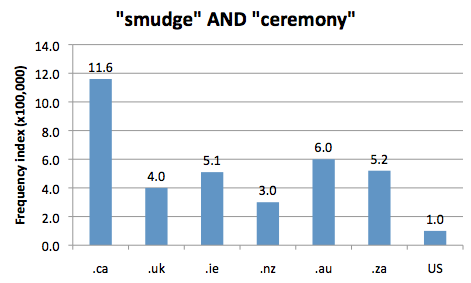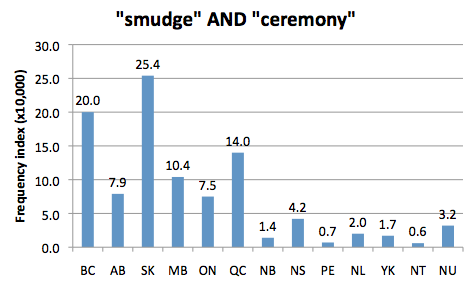Quick links
smudge
DCHP-2 (Jan 2015)
Spelling variants:smudging
1a†n. — Fur trade, Outdoors, especially Western & Northern Canada
an intentionally smoky fire for dispelling mosquitoes and frost.
A smudge is most frequently referenced in regards to keeping mosquitoes at bay from people and animals alike.
The term smudge may function as a modifier preceding "fire" (see the 1891 quotation).
The term smudge may function as a modifier preceding "fire" (see the 1891 quotation).
See: smudge (DCHP-1)
Quotations
1801
The women closed the openings of the cabins, and made a smudge inside.
1863
As a protection from the troublesome insects, several among the party carried smudges either of dry touchwood ... or of several pieces of cedar bark closely bound together; either of which retains fire and emits smoke without kindling into a blaze.
1887
In the summer the mosquitoes are very troublesome, and our little prairie pony used to come to the house door and make us understand it wanted a "mosquito smudge" lit (this is the Canadian name for a bonfire). The farm-house animals gather round these "smudges," preferring the smoke to the bites of the mosquitoes
1903
Talking about fires, adversity is like a smudge—it may be unpleasant, but it drives off the mosquitoes.
1935
[...] father said he was glad we had not come with them in the spring, for between the smoke of the smudges and the mosquito bites there wasn't much to choose.
1956
Build a small smudge fire inside the tepee, using hardwood chips and covered with bits of punk to produce a cool smoke.
1961
Flies and mosquitoes were in millions. Everywhere, when driving to town, one had to have a "smudge" in the wagon to ward them off.
2010
[...] avoid some cosmetic fragrances that could actually attract the insects. Light a smudge, burn a citronella candle or sit in a screened in porch or gazebo.
1b†n. & adj. — Fur trade, Outdoors, especially Western & Northern Canada
a can, pail, etc., often with a perforated bottom, used to build a smudge (see meaning 1a).
The term smudge may function as a modifier preceding "pot" (see the 1978 quotation).
Quotations
1829
. . . they keep a smudge always at the threshold of the door of the dwelling.
1921
"Telesphore . . . make us a smudge. Take the old tin pail."
1978
Sam Hambly carried a smudge pot or smoker as he called it, with smoke coming from the cedar shavings and damp leaves inside. "The theory is that when the bees smell the smudge they consume so much honey they aren't able to bend their abdomens to sting,"
1991
Smudge pots are so popular that cattle will head to the pots as soon as they're lit, Mr. Simcoe says
1c†n. — dated, Fur trade, Outdoors, especially Western & Northern Canada
the smoke that comes from a smudge (see meaning 1a).
Quotations
1880
The little enclosure, some ten feet square [is] fenced in to contain the extensive "smudge" of grass and leafy boughs, around which the horses gather on summer evenings to secure in the smoke a respite from the mosquitoes.
1939
If there had been a moon, a person coming over the hills would have seen that smudge as a perfectly level sheet closing the bowl like a lid.
1941
Smudge--An acrid smoke from green grass or turf for keeping mosquitoes away from a certain area.
1945
Here legs, shoulders and sides of pork and beef were hung in the smudge from smouldering sticks of beech, birch, hickory or maple, or from corn cobs.
2av. — Aboriginal, especially Western Canada
to cleanse one's spirit by fanning ceremonial smoke over oneself or someone else.
Type: 4. Culturally Significant — Smudging is a cleansing ceremony traditional to many Aboriginal communities. The term smudge in the context of ceremonies is most frequent in Canada (see Chart 1). The term is most prevalent in Western Canada, yet the practice is country-wide, perhaps even continent-wide (see Chart 2, where Saskatchewan, British Columbia and Quebec show the highest frequencies within Canada).
The ritual involves burning one or several materials, and then fanning the smoke over oneself to clear the air, mind and spirit. Sweetgrass, cedar, sage and tobacco are most commonly used in First Nations' ceremonies (see Canadian Encyclopedia reference). While practices vary, smudging is considered to be a way of driving away negative energies (see Mullin et al. 2001). The cleansing ritual entails an initial "washing" of hands with smoke, followed by covering the entire head and body with smoke (see Gov't. of Manitoba reference).
The ritual involves burning one or several materials, and then fanning the smoke over oneself to clear the air, mind and spirit. Sweetgrass, cedar, sage and tobacco are most commonly used in First Nations' ceremonies (see Canadian Encyclopedia reference). While practices vary, smudging is considered to be a way of driving away negative energies (see Mullin et al. 2001). The cleansing ritual entails an initial "washing" of hands with smoke, followed by covering the entire head and body with smoke (see Gov't. of Manitoba reference).
Quotations
1984
On the 10th anniversary of the clash, Mr. Harper, a Metis who is recognized in the native community for his teaching of native children, will start the school day by burning sweetgrass at the school while 60 students - about one-quarter of them non-Indian - sit in a circle and smudge their face with ashes in a purification rite.
1990
"Those bundles are still alive, but need treatment," Ridesatthedoor said. "Those things are crying for Indian people to smudge them, to treat them. I hope the museum will open the door to us."
1998
"Some people have no context or understand of what cleansing is." Buying a spiritual ceremony, or even the material to smudge, is a perversion of native custom. Daily, like most aboriginal people, gathers her own sweetgrass each year. "The sweetgrass grows in relationship with everything around it: the earth, the sun, the animals," she said.
2006
"I stood up and said that I could no longer smudge and do all of these things because I believed in God and I thought, 'Well, I guess they're going to kick me out of this Circle.' But they never did. They welcomed me there. Since then, and it's been 13 years now, I do smudge, and I do talk with the Elder."
2014
We smudge to clear the air around us. We smudge to clean our minds so that we will have good thoughts of others... We smudge our whole being so we will portray only the good part of our self through our actions.
2016
The round dance is a time for healing.
"Not only me, for everybody," Dianne said. "They're going to come there, they're going to smudge, they're going to pray and they're going to eat."
At the gathering, pictures of all the missing in Saskatchewan and those sent from Manitoba, B.C., Alberta and Ontario will be displayed.
2bn. & adj. — Aboriginal, especially Western Canada
a spiritual cleansing ceremony using the smoke from a variety of materials.
Type: 4. Culturally Significant — The term smudge is used interchangeably with smudging. Both smudge and smudging are also used attributively as modifiers preceding "ceremony" (see the 2000, 2001 quotations). See the 2014 quotation for the particular herbs used.
Quotations
1991
The Iroquois woman savors the sweet scent of the burning braid, lowering her head in silent prayer, and bathes her upper body in the soft white smoke. Today has been incredibly hectic, and Colorado finds an inner peace through her sweetgrass smudge.
1996
The young woman rises and brings around, to each of us sitting in the circle, a large shell with sage smoking in it. We are suppose to "smudge" before we pray. [...] After this smudging, the young woman rises again.
2001
J. B. Schuyler burned sage, sweetgrass, cedar and tobacco in a smudge ceremony all around the outside of the building on Riverside Drive West, waving an eagle wing feather over the smouldering herbs in an abalone shell.
2012
Tobacco, sage, sweet grass and cedar are used for various spiritual purposes in smudging ceremonies, where smoke is fanned over the face and head.
2014
Smudging is a tradition, common to many First Nations, which involves the burning of one or more medicines gathered from the earth. The four sacred medicines used in First Nations ceremonies are tobacco, sage, cedar and sweetgrass. The most common medicines used in a smudge are sweetgrass, sage and cedar.
2016
Brandon's WWOS stop also saw 200 community members volunteer their time to provide counselling and support to visitors and to keep the sacred fire burning.
Elder Frank Tacan led Thursday's two-hour ceremony, which commenced with a smudge and singing.
Just as the opening pipe ceremony welcomed the spirits of the missing and murdered women into the space, the closing service ushered them home.
"The body goes back to Mother Earth, but the spirit lives on ... so we have to honour that spirit," Tacan said. "If we don't do the closing ceremony, the spirits are stuck on Earth roaming around, crying, looking for a way home."
References
- Gov't of Manitoba • "Smudging Protocol and Guidelines"
- Mullin et al. (2001) • "A Native Smudging Ceremony: A Young Native Patient in Palliative Care Teaches His Caregivers a Less
- The Canadian Encyclopedia • "Indigenous Peoples: Uses of Plants"
Images

Chart 1: Internet Domain Search, 20 Apr. 2016
